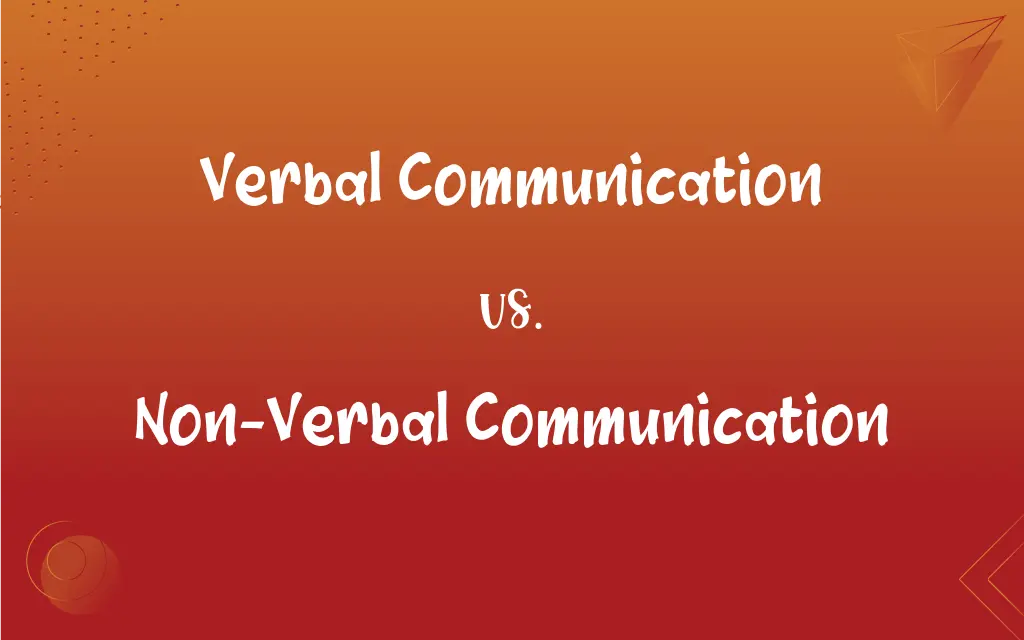Verbal Communication vs. Non-Verbal Communication: What's the Difference?
Edited by Aimie Carlson || By Janet White || Published on February 16, 2024
Verbal communication involves the use of words, spoken or written, while non-verbal communication encompasses gestures, body language, facial expressions, and tone of voice.

Key Differences
Verbal communication is the articulation of thoughts and ideas through spoken or written words, making it a cornerstone of human interaction. Non-verbal communication, on the other hand, operates silently but powerfully through gestures, facial expressions, body language, and even tone of voice, offering a parallel narrative to spoken words. While verbal communication relies on the structure and vocabulary of language to convey clear and specific messages, non-verbal communication often thrives in the realm of subtlety, where unspoken cues and body language speak volumes. This contrast illustrates how verbal communication can be direct and explicit, whereas non-verbal elements often convey messages that are implicit and open to interpretation.
In the context of conveying emotions and feelings, verbal communication can sometimes fall short, limited by the speaker's vocabulary and the listener's interpretation. Non-verbal communication excels in this arena, as it transcends linguistic barriers, allowing emotions to be expressed more universally through facial expressions, gestures, and body posture. For example, a smile or a frown can communicate happiness or displeasure far more effectively than words in many situations. However, the precision and clarity that verbal communication provides, especially in complex or detailed discussions, cannot be matched by non-verbal means, which are more nuanced and can be subject to misinterpretation across different cultures.
The role of culture in shaping both verbal and non-verbal communication is significant. Verbal communication varies dramatically across languages and dialects, with each having its idioms, jokes, and references that might not translate well across cultural boundaries. Non-verbal communication also has its cultural nuances; for instance, a gesture considered polite in one culture might be offensive in another. While a verbal message can be translated from one language to another, non-verbal cues are often more deeply ingrained in cultural practices and can be harder to adapt or interpret accurately in different cultural contexts.
In professional and academic settings, verbal communication is often the primary mode of information exchange, relying on well-structured arguments, presentations, and written documents. Non-verbal communication, however, plays a supportive role in these environments, enhancing or undermining the spoken or written word through body language, eye contact, and the speaker's tone. For instance, a confident posture and steady eye contact can reinforce the authority of a speaker's verbal message, while inconsistent body language can detract from the credibility of the spoken words.
The evolution of technology has impacted both verbal and non-verbal communication. Digital communication platforms have revolutionized verbal communication, allowing for instant written and spoken exchanges across vast distances. However, these platforms also limit non-verbal communication, often reducing it to emojis or video call features that attempt to replicate face-to-face interactions. This technological shift underscores the importance of both forms of communication, highlighting how they complement each other to convey complex human thoughts and emotions effectively.
ADVERTISEMENT
Comparison Chart
Medium
Words (spoken/written)
Gestures, body language
Clarity
Can be explicit
Often ambiguous
Cultural Influence
Language specific
More universally understood
Expressiveness
Limited in conveying emotions
Highly expressive of emotions
Change and Adaptation
Evolves with language
More consistent and innate
ADVERTISEMENT
Verbal Communication and Non-Verbal Communication Definitions
Verbal Communication
It articulates ideas and opinions.
Democracy is essential for freedom.
Non-Verbal Communication
Non-verbal communication involves gestures and expressions without words.
A nod indicates agreement.
Verbal Communication
Verbal communication is expressing thoughts through words.
I feel happy today.
Non-Verbal Communication
It's an implicit way of communication.
Maintaining eye contact shows interest.
Verbal Communication
Verbal communication is the exchange of information via language.
The meeting is at 3 PM.
Non-Verbal Communication
It includes body posture and movements.
Crossing arms can indicate defensiveness.
Verbal Communication
It involves structured dialogue or written text.
Let's discuss the project details.
Non-Verbal Communication
Facial expressions convey a range of emotions.
Raised eyebrows can indicate surprise.
Verbal Communication
It can convey emotions through tone and choice of words.
I'm really excited about this opportunity!
Non-Verbal Communication
It expresses emotions more subtly than words.
Smiling to show happiness.
FAQs
How does culture affect verbal communication?
Different cultures have unique verbal nuances and expressions.
Can verbal communication be non-direct?
Yes, it can be indirect, such as using metaphors or implied meanings.
What is non-verbal communication?
It includes gestures, facial expressions, and body language to communicate without words.
Can non-verbal communication be misinterpreted?
Yes, non-verbal cues can be ambiguous and interpreted differently.
Are gestures a form of non-verbal communication?
Yes, gestures are a significant part of non-verbal communication.
Can verbal communication be less effective than non-verbal?
In some situations, non-verbal cues can convey more than words.
How does technology impact verbal communication?
Technology allows for new forms of verbal communication, like texting and email.
What is verbal communication?
It's the use of words, spoken or written, to convey a message.
What role does facial expression play in non-verbal communication?
Facial expressions can convey emotions and reactions non-verbally.
Is verbal communication more important than non-verbal?
Both are important; verbal provides clarity, while non-verbal conveys emotions.
How do emotions influence verbal communication?
Emotions can affect tone and choice of words in verbal communication.
What is the role of eye contact in non-verbal communication?
Eye contact can signal attention, respect, or aggression.
Do body posture and movement impact non-verbal communication?
Yes, they can indicate attitudes and feelings.
Is it possible to communicate non-verbally online?
Yes, through emojis, video, and other visual cues.
Is non-verbal communication universal?
Some aspects, like basic facial expressions, are universal, but many are culturally specific.
Can silence be a form of non-verbal communication?
Yes, silence can convey agreement, disagreement, or contemplation.
How do tone and inflection relate to verbal communication?
They add emotional context and emphasis to spoken words.
How do speech patterns affect verbal communication?
Speech patterns can indicate cultural background, emotions, and attitudes.
What is the significance of touch in non-verbal communication?
Touch can convey comfort, aggression, or affection, depending on the context.
How does context affect verbal communication?
Context can influence the interpretation and appropriateness of verbal messages.
About Author
Written by
Janet WhiteJanet White has been an esteemed writer and blogger for Difference Wiki. Holding a Master's degree in Science and Medical Journalism from the prestigious Boston University, she has consistently demonstrated her expertise and passion for her field. When she's not immersed in her work, Janet relishes her time exercising, delving into a good book, and cherishing moments with friends and family.
Edited by
Aimie CarlsonAimie Carlson, holding a master's degree in English literature, is a fervent English language enthusiast. She lends her writing talents to Difference Wiki, a prominent website that specializes in comparisons, offering readers insightful analyses that both captivate and inform.







































































